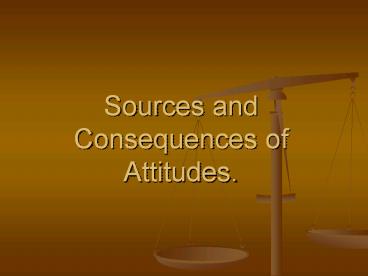Sources and Consequences of Attitudes. - PowerPoint PPT Presentation
Title:
Sources and Consequences of Attitudes.
Description:
Sources and Consequences of Attitudes. Objectives Define attitudes Describe job satisfaction and its relationship to productivity Explain the theory of cognitive ... – PowerPoint PPT presentation
Number of Views:114
Avg rating:3.0/5.0
Title: Sources and Consequences of Attitudes.
1
Sources and Consequences of Attitudes.
2
Objectives
- Define attitudes
- Describe job satisfaction and its relationship to
productivity - Explain the theory of cognitive dissonance
3
Summary (cont.)
- Discuss the relationship between attitudes and
behaviors - Examine attitude change
4
Key Variables Affecting Individual Behavior
Values
Motivation
Attitudes
IndividualBehavior
Perception
Personality
Learning
Ability
5
Attitudes
Evaluative statements favorable or unfavorable
about objects, people, or events reflect how
one feels about something
6
Job Satisfaction
Refers to an individuals general attitude toward
the job when people speak of employee attitudes,
often means job satisfaction
7
What Determines Job Satisfaction?
- Evidence indicates that the most important
factors conducive to job satisfaction are - Mentally challenging work
- Equitable rewards
- Supportive working conditions
- Supportive colleagues
8
Satisfaction and Productivity
- Evidence shows that satisfactions effect on
productivity is fairly small - Productivity can be increased
- More by removing outside constraints than by
influencing satisfaction - By introducing organizational rewards for
productivity, such as - Verbal Recognition
- Pay Level
- Probabilities for Promotion
9
Cognitive Dissonance
Inconsistencies betweentwo or more of a persons
attitudes or between a persons behavior and
attitudes
10
Reducing Dissonance
- If elements creating dissonance are relatively
unimportant, pressure to correct imbalance will
be low - Degree of influence over the elements will impact
how we react to dissonance - Rewards influence the degree that we are
motivated to reduce dissonance
11
The Attitude-Behavior Relationship
- Social constraints moderate behavior
- Although some hold contradictory attitudes,
pressures are toward consistency - Other things besides attitudes influence behavior
- Attitudes do influence behavior
12
Perception
Process by which people organize and interpret
their sensory impressions in order to give
meaning to their environment
13
Factors Influencing Perception
- Operate to shape and sometimes distort perception
- Reside in the perceiver
- Part of the object or target being perceived
- Exist in the context of the situation in which
the perception is made
14
Attribution Theory
- Judging people differently depending upon meaning
attributed to a behavior - Determine whether caused internally or
externally, depending upon - 1. Distinctiveness - different behavior in
different situations - 2. Consensus - same behavior in similar
situations - 3. Consistency - same behavior over time
15
Fundamental Attribution Error
- In Others
- Underestimating influence of external factors
- Overestimating influence of internal factors
- Self-Serving Bias
- Attributing success to internal factors
- Blaming external factors for failure
16
Shortcuts to Judging Others
- Selectivity - choosing bits of data depending on
the interests, background, experience, and
attitudes of observer - Assumed Similarity - perceptions of others more
influenced by what the observer is like or thinks - Stereotyping - basing perception on group
membership or association - Halo Effect - drawing a general impression on the
basis of a single characteristic, such as
intelligence, sociability, or appearance































